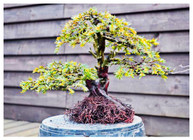Posted by Chuck Iker on 28th Dec 2023
Bonsai Pot Selection From a Different Perspective
I am often asked for advice on which bonsai pot would go well with a particular tree. While I am always willing to assist with selection, I realize that my answers often seem vague to those asking. As a potter and artist I'd prefer that you own a pot that speaks to you. As a bonsai potter I know that there is more to selection than just liking the pot. The overall objective is to seek harmony between bonsai and vessel. So what is the formula? While I've seen selection defined in mathematical relationships, the numbers neatly arranged in spreadsheet format, there is much more to consider.
I use a very simple principal when matching pot to tree. It involves the first glance at the composition. As in a painting the artist works to control the movement of the eye. A good composition makes an immediate statement. It is harmonious and evokes emotion. If you see a tree that is out of balance with its vessel then the landscape is disturbed. If your eyes immediately jumps to the pot then possibly the pot is not correct for the tree. Neither can overpower the other. They must work harmoniously.
That being said, we must deal with a wide variety of experience and taste in making these judgments about composition. It is absolutely my "potter" opinion that if you like your composition that is all that matters. It is your statement and it is for your enjoyment. No one has the right to question unless….. you decide to put yourself in a position to invite critique by entering shows. If competition and public display is part of your enjoyment then you need to understand and follow somewhat general protocols as you will be judged on your adherence. You'll likely not be taken very seriously by planting you bonsai in a football helmet or bed pan. There's a tad more structure to the art than that. Although, I have made everything from a skull to a pile of bones for some clients. I applaud their creativity and the rebel in me says, trip on that!
In reviewing my collection of books on bonsai I find some discussion on the topic of pot selection but rarely more than a few pages here and there. The Web offers more on the topic. I’m not going to recreate the list of “standards”. Pot dimensions relative to trunk caliper, height, and style follow good general advice. They help you move toward a balanced composition. Lists, rules, and protocols just irritate me. If you concentrate on the composition the rules should be met.
We need to keep in mind what our art depicts. It mimics trees in their natural environment in a diminutive form. A broom style may mimic the delicate stance of a tree on a pasture hillside. It may be surrounded by a pasture of flowering grasses. This landscape requires a pot that is gentle and natural in design and color.
Some create jin to mimic the effects of lightning strike or wind blast on an exposed tree. This image is strong and feral. It mimics the harsh and rugged effects of nature upon nature. The pot needs to add to this image to complete the landscape. Some compositions depict the rugged existence of an alpine tree surviving in spite of nature. This composition would lend itself to an unglazed organic or primitive form. Work the landscape you are trying to replicate. Place the tree in its natural environment. The composition should take you there, where the tree lives. The pot should complement that image.
We all keep pictures of favorite bonsai trees and pots we find on the internet and social media. Along with your portfolio of bonsai pictures it is also worthwhile to keep images of interesting trees and tree shapes from nature. These are excellent stimulators of ideas and styling options. I find them to be a wonderful place to go for artistic inspiration. My vacation pictures always include shots of interesting trees in interesting locations.
Organic combinations of colors are found in nature. The environment in which the native tree lives can lead you toward pot surface, styling, and shape. So here we are again, no specific recommendation, no list of standards, no protocols to follow. Finding that perfect pot/tree combination is all part of the mystique and beauty of Bonsai. It is a work in progress. It is your expression and creation of art.
I have one more final test of your composition. Does it make you smile? Does it bring you joy? Can you not walk past it without stopping and admiring? If it does, perfection has been achieved, even if it’s a football helmet.
This picture was taken by my son on his 2,600 mile hike of the Pacific Crest Trail in 2011. It is a favorite of mine as a fine example of natural trees in their native settings. These trees can be thousands of years old and could tell tales of centuries past. Pot selection for a replication of this tree is obvious. There are no smooth lines. There are no gentle curves. There is only the raw emotion of life on the edge. Your pot selection here should carry that emotion.


